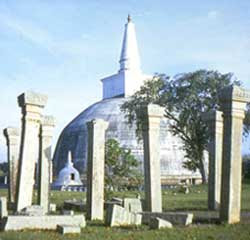
Anuradhapura is an ancient city, located at a distance of 206 km from Colombo. The city is in northern Sri Lanka and is the capital of North-Central province. Anuradhapura was established in 4th century BC. It was the first capital of Sri Lanka and remained so until 8th century AD. Anuradhapura is an archaeologist's delight and contains several monuments of historical importance. The city is considered very sacred by the Buddhists and is home to the largest dagobas in Sri Lanka. A dagoba is a dome enshrining sacred relics or the bodily remains of the Buddha, or articles used by Him like the alms bowl and other objects of veneration. It is built in different sizes on a pedestal with a spire on top crowned with a pinnacle. The earliest dagobas had a stone umbrella on top of the dome in place of the spire.

Places to See -
Sri Maha Bodhi Tree: The right branch of the Bodhi tree in Bodh Gaya in India under which the Buddha attained enlightenment was brought to Sri Lanka in the 3rd century BC by princess Sanghamitta, the daughter of Emperor Asoka. It was planted in Anuradhapura and is venerated to this day by the Buddhists from many countries of the world. This is the oldest recorded tree in the world whose exact age is known.
Thuparma Dagoba: Thuparama is the first dagoba to be built in Anuradhapura during the reign of King Devanmpiyatissa (3rd century BC) enshrining the right collarbone of the Buddha, His alms bowl and other relics.
Ruvanveli Dagoba: Ruvanveli Dagoba built by King Dutugemunu who ruled the country in the 2nd century BC is a huge dagoba measuring 103 metres in height with a circumference of 287 metres.
Jetavana Dagoba: Jetavana dagoba was built in the 3rd century AD by King Mahasena. It is an enormous brick structure standing in the centre of a large monastic complex measuring 3.2 hectares in extent and is rated as the largest and tallest brick built monument in the world. The structure has been declared a World Heritage Site.
Abhayagiri Dagoba: This Dagoba was built by King Valagam Bahu (1st century B.C.) and it is the Sri Lanka's second highest dagoba. It was at the Abhayagiri complex that the sacred Tooth Relic of the Buddha brought to Sri Lanka was first housed.

Samadhi Buddha: This 4th Century AD statue of the Buddha in meditative pose is a world famous Buddha statue and acknowledged as a masterpiece.
Isurumuniya: It is a picturesque rock temple built in the 3rd century BC. The beautiful stone sculptures seen at the temple are considered the most beautiful works of art in Anuradhapura.
Mihintale: Thirteen kilometers from Anuradhapura is the sacred mountain of Mihintale, the site of introduction of Buddhism to Sri Lanka in the year 247 BC. World's first fauna and flora sanctuary was established at Mihintale in the 3rd century BC. Today the peak of Mihintale, approached by a grand stairway of 1840 granite steps, has many temples, lodgings for monks and several splendid statues of the Buddha. Each June on the full moon there is a pilgrimage commemorating the date when Mahinda first preached the Buddhist doctrine in Sri Lanka and many thousands of pilgrims flock from all over Sri Lanka to meditate on the holy peak.
Awkana: Awkana-located 51 km southeast of Anuradhapura-is famous for 12 metres tall granite statue of Buddha, hewn out of solid rock in the standing posture on a lotus pedestal. The statue was built during the reign of King Dhatusena in the 5th century AD.
Kuttam Pokuna: Kuttam Pokuna or the Twin Ponds-the two breathtakingly beautiful bathing ponds aligned lengthwise-is a manifestation of the artistic achievements in the field of hydraulic engineering in ancient Sri Lanka. They date back to around 8-10th century AD.












